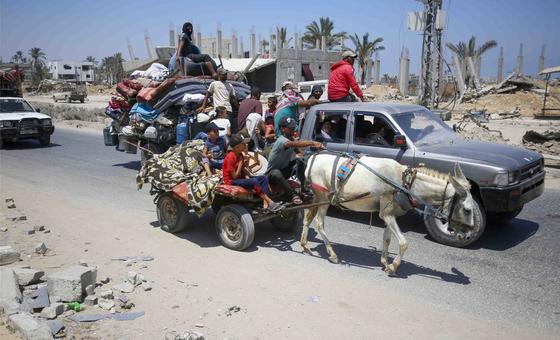The development comes as media reports indicated that truce and hostage swap talks in Doha scheduled on Thursday in Qatar had been postponed until early next week. Some 116 hostages are still missing, with 44 believed to have died, reports say, nearly 10 months since Hamas-led terror attacks on multiple targets in southern Israel left around 1,250 dead and more than 250 taken captive.
In a bleak assessment of hunger levels in Gaza late Wednesday, the UN aid coordination office, OCHA, warned once again that too little relief is reaching the people who need it most.
“Insecurity, damaged roads, the breakdown of law and order, and access limitations continue to hamper movement along the main humanitarian cargo route between Kerem Shalom Crossing and Khan Younis and Deir al Balah,” the UN agency insisted.
Community kitchens at risk
OCHA noted that ongoing insufficient deliveries of both fuel and aid supplies from central/southern Gaza to the north have left six bakeries in northern Gaza – four in Gaza city and two in north Gaza – receiving “only scarce” quantities that have been sufficient to keep them running for a few days at a time.
“Critical shortages” of commodities have impacted community kitchens and increased the “risk of spoilage and infestation of stranded food supplies” amid scorching summer temperatures, it warned.
“In addition, hot meal production capacity in Gaza and North Gaza governorates has been insufficient to support tens of thousands of newly displaced people,” OCHA continued, as it explained that “the lack of entry of commercial supplies into northern Gaza for nearly three months has resulted in a near total lack of protein sources such as meat and poultry on the local market.”
Today in northern Gaza, only a few types of locally produced vegetables are available at “unaffordable” prices, the UN agency explained, while warning that the lack of “seeds, fertilizers and other animal and crop production inputs” remained “a key obstacle” to restoring local food production in Gaza.
OCHA also pointed to Israeli military operations that have devastated Rafah since early May and sparked an exodus this week from eastern Khan Younis, “where significant agricultural production was concentrated prior to the war”.
In addition to the latest damage caused to greenhouses, Gaza’s farms and fields are now unattended. “The implications of missing the upcoming agricultural season will likely devastate people’s livelihoods,” the OCHA update warned.
That assessment is in line with previous alerts from the UN Food and Agriculture Organization (FAO), which highlighted that agriculture in the Gaza Strip represents over 40 per cent of the enclave’s surface area and contributes up to 30 per cent of daily consumption.
“The damage to the agricultural sector due to the hostilities is extensive, bringing crucial local production of fresh and nutritious food to a near total halt, decreasing the population’s access to essential food items required for a healthy diet,” it said.
According to the latest UN-partnered IPC report on hunger levels, 96 per cent of the population in Gaza – some 2.15 million people – face acute food insecurity at “crisis” level or higher. That’s level three of the Integrated Food Security Phase Classification (IPC) index (check out our explainer on the IPC system here).

